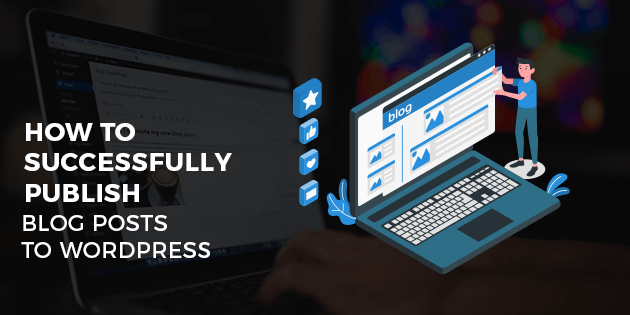Making the best possible blog posts requires advanced functionality and customisation options. Luckily, WordPress has all the tools to help you achieve just that.
WordPress currently powers about a third of all websites – quite a staggering number. With its loyal community, open-source architecture, and a growing number of customers, the platform continues to improve the features on offer.
The powerful CMS started primarily as a blogging platform and, in line with that tradition, blogs are still at its core today. WordPress now has everything you need to launch and maintain a blog – from design choices to hosting.
The hundreds of themes and designs available can be customised to suit your brand and the overwhelming number of plugins can make your blog unique. Your blog will also be optimised for SEO and social media sharing right from the get-go. And with the built-in mobile responsiveness, your content can reach your audience on any device.
If you need guidance, the basic WordPress platform has detailed statistics to help you see how your blog performs with different audiences. Additionally, there’s a plethora of tutorials, forums, and other means of support to guide you through the process of building the best blog page possible.
And this is without mentioning the additional functionality range covered by thousands of plugins or the extended capabilities that come with the paid plans.
In essence, if you want to start blogging, WordPress has every aspect of it covered. However, how well your blog does will always depend on how you use all that the platform offers.
As in all things, there’s a wrong and a right way to go about it, which is why we’ve created this list of tips to help you successfully publish a blog post to WordPress.

Tip #1. Get the Basics Right
The elementary factor in creating a quality blog post in WordPress is understanding how the editor works. While it’s relatively straightforward, knowing exactly how to use this essential tool’s powerful potential will prove invaluable.
WordPress features a block editor, which means you can add various content blocks to the page. The first thing you’ll see is a clean interface that contains a box for your post title and a few buttons.
You’ll want to start by entering the title. After that, you can begin adding content blocks to your blog post. There are two ways to do this – either by clicking on the circled plus button or using keyboard shortcuts.
The primary content blocks you’ll have access to include:
- text
- images
- embedded content
- shortcodes
- widgets
While there’s even more of them, and different plugins can provide other blocks, the listed ones are the essentials to get you started.
Getting some practice with adding and organising different blocks is a must before moving on to the more advanced features. Knowing your way around the basics would already be enough to publish a rudimentary blog post, but there’s so much more you can do.
Tip #2. Add Stunning Images and Do it Quick
People are exceptionally visually oriented. So it’s no wonder you could easily get stuck on choosing the right image for your post.
While attention to detail is a valuable trait, you’ll want to reduce the time spent on the visuals as much as possible and use it to get other elements in order. After all, images are there to accompany your post, not necessarily to be the crux of it.
Here’s where plugins come in.
You can use a stock image plugin to access millions of free images right from the built-in media library.
But if you want to go further and customise the graphics, there’s a plugin for that, too. Installing an image editor plugin will allow you to trim pictures, add effects or text, and much more.
Finally, you can use a plugin to optimise the images for blog posts automatically.
Working with plugins and ensuring they function as intended might require some time and fiddling. But once you unlock their incredible functionality, you’ll end up saving time.
Tip #3. Use Shortcodes
Shortcodes serve as excellent tools for adding features to your blog posts. Not only that, but they can also vastly improve the effectiveness and convenience of the blogging process.
Keep in mind that you won’t find many of them in the core WordPress app, as they’ll more likely come from different plugins or themes. So if you remove a theme, its shortcodes will also disappear.
So how can you ensure to keep the desired formatting or features provided by shortcodes?
Of course, by using a dedicated plugin.
Some plugins cover a wide range of shortcodes, such as Shortcodes Ultimate. However, you can also use a specific plugin that takes care of a particular shortcode type.
Whichever method you decide on, always remember to secure this element of your blog post, lest you lose the precious layout you’ve spent so much time building.
Tip #4. Don’t Forget Tags and Categories
Returning to the built-in functionality, you’d be wise to make the most use of tags and categories. Those are taxonomies that allow for efficient content organisation and they play more of a vital role in your blog’s success than it would seem.
Categories are used to group your posts by topic. Assigning a category is mandatory, as there’s a default one specifically for posts you don’t file under a specific taxonomy.
Tags, on the other hand, are entirely optional. They are meant to provide crucial details about your posts and help make them easier to find by searching for relevant terms. Think of tags used on social media platforms – they serve a similar purpose on WordPress blog posts.
Tags and categories are handy for SEO, although their most apparent benefit comes from organising your content. Categories are particularly useful to this end as they are hierarchical, which means you can create subcategories to differentiate specific topics better.
Tip #5. Eliminate Distractions While Publishing
Your blog post’s real value and subsequent success will always depend on the very content.
It’s easy to get lost in the details and the numerous features that constantly invite you to play around with them. That’s why you need to make sure your writing process doesn’t suffer due to distractions.
You might think there’s a plugin to help you with that. But in this case, the basic WordPress editor already has it covered.
You’ll find a dedicated button to toggle the Distraction-free mode on the top right. Doing so will remove all sidebars and even dim the main menu, leaving only the text editor on your screen and allowing you to concentrate on your writing.
But if you’re working on a browser, more distractions will be waiting in the very next tab. And the only thing keeping you away from the allure of procrastination will be your willpower.
Instead of struggling with the temptation, you could abandon the browser and take your writing to a dedicated app.
The most straightforward option is to use the WordPress desktop app. It will provide you with a streamlined, distraction-free writing experience while still allowing you to access the WordPress Dashboard. Fortunately, it works on Windows, Mac, or Linux.
You can also use any other word processor to write a post and schedule it for later publishing. If you need assistance with this task, Automation Agency is glad to help. Concentrate on your writing and let our Web Heroes take care of the publishing schedule.
Tip #6. Take Advantage of Plugins
While you can create a decent WordPress blogging website and publish posts using nothing more than the core options, there’s no reason to miss out on the incredible flexibility provided by the thousands of plugins available.
You can use plugins for everything – from writing aids to social media promotion and SEO. Here are some of the select plugins that could benefit your blog:
- To check the quality of your writing, there’s Grammarly. Although it isn’t a WordPress plugin but rather a browser extension, the app is designed with seamless integration in mind. It will catch every mistake in spelling or grammar that might slip through, making your writing tighter and more on point. It can never replace a human editor, but it should improve your style nonetheless.
- If you want to customise a theme of your choice, a plugin like CSS Hero can make this very straightforward. You can edit the layout through a point-and-click interface, allowing you to change colours, fonts, or any other element with ease. The best thing about this plugin is that it allows for significant customisation without meddling with code, making it perfect for newcomers to the platform.
- We’ve already mentioned how plugins can help you with images for your posts, and Envira Gallery is one of them. It presents a handy, beginner-friendly solution useful for creating galleries or albums without impacting the load time. This can be incredibly convenient if you’re running a blog focused on photography and want to display your images in a captivating manner.
- To reach the widest audience possible, you should consider using a dedicated plugin like Yoast SEO. It will ensure your blog posts and the entire website are optimised for SEO and attract more visitors from the prominent search engines and social media platforms.
Naturally, these suggestions don’t even scratch the surface of the benefits that come with WordPress plugins. With some research, you’ll find a free or premium plugin that will make almost every idea possible.
Tip #7. Edit the Permalink
As a short but crucial final tip, we recommend changing the URL, or permalink, of your post before you publish.
WordPress will automatically generate a permalink using your post title. While the process is made with SEO in mind, you might find a custom URL more effective and user-friendly.
You can change the URL by clicking on the title and editing it through the option that shows up. Another way to do this is to go to the document setting and edit the permalink from the appropriate tab.

Give Your Blog the Proper Boost
Paying attention to the design, content quality, useful features, and vital available options will make it more likely for your blog to soar to great heights. And if you can get a firm grip on all the elements that make a great blog, nothing will stop you from succeeding.
But while some individual features are relatively easy to use, the whole process can be challenging. That’s where Automation Agency comes in. With the help of our Concierge Service, your blog posts can thrive in no time.
Go to this link to find out about the full range of our services and start growing your blogging website now.


